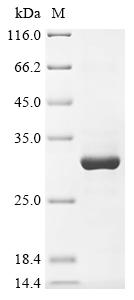The recombinant Rat Trpa1 protein production is accomplished by manipulating the expression of the desired gene in e.coli cells. The sequence (960-1125aa) of foreign DNA is incorporated into an expression vector and subsequently introduced into e.coli cells. Positive cells are selected and cultured to induce the expression of the desired protein. The protein carries a N-terminal 10xHis tag and C-terminal Myc tag. The resulting recombinant Rat Trpa1 protein undergoes affinity purification, with a purity surpassing 85%, as measured by SDS-PAGE.






